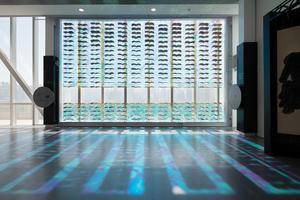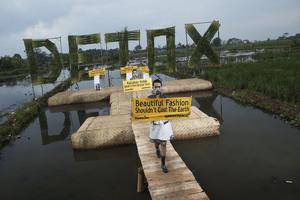In Part 3 of a series on how the new and upcoming museums of Hong Kong stack up against their counterparts on the Chinese mainland, Chitralekha Basu looks at the roles museums play in safeguarding environmental sustainability as well as their own financial health in the time of COVID-19.
 (PHOTO PROVIDED TO CHINA DAILY)
(PHOTO PROVIDED TO CHINA DAILY)
Museums consume prodigious amounts of energy and “there is no way around it until architects can come up with more innovative ways of exhibiting and protecting museum collections,” says Lee Ho-yin, director of Architectural Conservation Programmes, Faculty of Architecture, the University of Hong Kong. The volume of energy a museum needs to burn is directly proportional to the nature of its collection and exhibits, Lee points out.
At a time when museums are expected to have a role in maintaining earth’s ecological balance, the likes of the upcoming Hong Kong Palace Museum, which will show a number of fragile Grade I objects on loan from the Palace Museum of Beijing, have to work harder than a museum of contemporary art to reduce their carbon footprint.
 Kohei Nawa’s PixCell Red Deer in the atrium of the He Art Museum, Foshan, beautifully unites the ideas of art and nature. (PHOTO PROVIDED TO CHINA DAILY)
Kohei Nawa’s PixCell Red Deer in the atrium of the He Art Museum, Foshan, beautifully unites the ideas of art and nature. (PHOTO PROVIDED TO CHINA DAILY)
Environmental sustainability was factored into the extensive renovation plan for Hong Kong Museum of Art, which went through a complete overhaul prior to its November 2019 reopening. Home to Chinese antiquities from the Neolithic era among various other equally delicate objects, HKMoA’s “new construction works employ green building designs and proposals with energy-saving measures,” informs museum Director Maria Mok.
“New glass facades and skylights of the museum are fitted with high-performance low-e glazing. Equipped with good insulation, low reflection and high transmittance, it reduces internal heat gain effectively and leads to lower electricity consumption for air-conditioning,” says Mok. The introduction of smart technology, such as “high-performance air-cooled chiller with variable speed drive” and “automatic demand control air supply system, and LED lights”, has raised the museum’s energy efficiency by several notches.
 Summer Day Poem in Regular Script, from Northern Song Dynasty (1111-1118 CE). The safekeeping of items such as these will consume a lot of energy. (THE PALACE MUSEUM / FOR CHINA DAILY)
Summer Day Poem in Regular Script, from Northern Song Dynasty (1111-1118 CE). The safekeeping of items such as these will consume a lot of energy. (THE PALACE MUSEUM / FOR CHINA DAILY)
HKMoA also champions recycling. “The original façade and wall tiles of the museum are preserved so as to reduce construction waste,” says Mok. Some of these tiles went into Raymond Fung’s installation made for the museum’s opening exhibition in which he paid homage to the father of modern Chinese painting Wu Guanzhong (1919—2010).
“There is also green landscaping in suitable parts of the building, including horizontal greening, vertical greening and green roof,” Mok adds.
HKMoA is encouraging its patrons to be eco-sensitive as well. The traditional paper comment book has been replaced with iPads. The number of exhibition booklets was cut down as visitors can access detailed information on the shows through downloadable QR codes instead.
 Raymond Fung used recycled tiles from the renovation work of the Hong Kong Museum of Art to create new art for the museum. (PHOTO PROVIDED TO CHINA DAILY)
Raymond Fung used recycled tiles from the renovation work of the Hong Kong Museum of Art to create new art for the museum. (PHOTO PROVIDED TO CHINA DAILY)
Sisterhood of museums
The significance of sharing resources seems to have increased by several folds in the light of COVID-19 which forced many museums around the world to stay shut for prolonged periods of time and drastically reduced the possibility of international travel. With loss of income and restrictions on mobility, the idea of resource sharing between neighboring museums seems not just a viable option but an ideal to pursue.
“We’re trying to minimize freight shipping and look at how we can share major institutional collection exhibitions across our immediate neighborhood,” says M+ Museum Director Suhanya Raffel. “When we do European shipping or US shipping into Asia, we look at maybe a group of us (museums in the region) working together to share the costs, so that the works are seen by a much greater number of people, and the carbon footprint doesn’t blossom into something unsustainable.”
 Greenpeace detox catwalk in Bandung, Indonesia, from the Fashioned from Nature exhibition at Design Society. (PHOTO PROVIDED TO CHINA DAILY)
Greenpeace detox catwalk in Bandung, Indonesia, from the Fashioned from Nature exhibition at Design Society. (PHOTO PROVIDED TO CHINA DAILY)
M+ has signed an MOU with Power Station of Art museum in Shanghai.
“We’re also looking at Tokyo, Singapore and Beijing. We have an established network with museums in these cities and are working to amplify it,” says Raffel. “We will probably expand the sharing around travelling exhibitions or exhibitions on loan from other museums, which will continue to happen because an important part of the museum ethos is to share our collections.”
Daisy Wang Yiyou, deputy director, Curatorial and Programming, HKPM, agrees.
“It is crucial for us to build and sustain our local network and support base,” says Wang. “We are working very closely with our neighbors, such as M+, HKMoA, Hong Kong Heritage Museum, and university museums. And of course, we are working remotely and collaboratively with our key partner, the Palace Museum in Beijing. We share the same goal of making Hong Kong an international hub for art and culture, and the only way to do it is to work together.”
 A “grape” dress made out of vegea, a leather alternative made with grape waste, at the Fashioned from Nature exhibition, now running at Design Society, Shenzhen. (PHOTO PROVIDED TO CHINA DAILY)
A “grape” dress made out of vegea, a leather alternative made with grape waste, at the Fashioned from Nature exhibition, now running at Design Society, Shenzhen. (PHOTO PROVIDED TO CHINA DAILY)
Building a sisterhood of museums in China’s Guangdong-Hong Kong-Macao Greater Bay Area is eminently possible, feels Shao Shu, director of the He Art Museum in Foshan, Guangdong province.
“There are around 900 private museums in China now. An increasing number of art fairs, expos and conferences are happening in the Bay Area, especially in Guangzhou and Shenzhen, which serve as a platform to connect these art institutions,” he says.
“As the Bay Area is a key national development strategy, and the government of China maintains an open, inclusive and supportive attitude towards cultural development. Therefore, the entire development environment is sound,” Shao adds.
The pandemic has inspired a readiness in museums to work as a community.
“I see the barriers of collaboration between organizations getting gradually eliminated. There will be more and more joint research, and co-hosted public programs among institutions and industry professionals to exchange ideas and experience in the community,” Shao says.
 Design Society hosts exhibitions drawing attention to caring for nature, says Museum Director Ole Bouman. (PHOTO PROVIDED TO CHINA DAILY)
Design Society hosts exhibitions drawing attention to caring for nature, says Museum Director Ole Bouman. (PHOTO PROVIDED TO CHINA DAILY)
Sustainability shows
Putting on environment-themed shows is perhaps the most obvious way for museums to demonstrate their commitment to protecting the planet. This is what Shenzhen’s Design Society has been doing since their 2017 opening.
Design Society’s deputy director Zhao Rong says the museum has presented large-scale themed exhibitions featuring internationally-acclaimed artists, designers, artisans, scientists and practitioners, responding to the themes of sustainable development and environmental protection, among others. For instance, “In 2017, Minding the Digital offered a journey exploring how design professionals are responding to digitization. In 2018, Craft: The Reset showed the revival of crafts in contemporary design and society,” she says,
 Daisy Wang Yiyou of the Hong Kong Palace Museum says Hong Kong museums are working together to make the city a cultural hub. (PHOTO PROVIDED TO CHINA DAILY)
Daisy Wang Yiyou of the Hong Kong Palace Museum says Hong Kong museums are working together to make the city a cultural hub. (PHOTO PROVIDED TO CHINA DAILY)
Their current show is called Fashioned from Nature. Presented jointly with London’s Victoria and Albert Museum, the display examines the layered, fraught and closely intertwined relationship between the worlds of fashion and nature, besides offering creative solutions toward making the fashion industry more sustainable.
“China National Silk Museum has contributed a special section, Fashioned from Nature in China: Then and Now, guest-curated by Edith Cheung Sai-may, which investigates how nature has been inspiring Chinese historic costumes and textiles, presenting nearly 400 garments and accessories across almost 2,300 years,” says Design Society Director Ole Bouman.
“We can’t wait to offer this first Design Society show fully dedicated to fashion, from our signature angle of understanding design as a societal act to our audience. Through this exhibition, we aim to create dialogues between Chinese and Western perspectives on nature embodied in their respective history of cloth making and consumption, projecting into a more planetary, sustainable future,” he adds.
 Journalist Rebecca Lo suggests Hong Kong museums try enlisting the support of the city’s business community. (PHOTO PROVIDED TO CHINA DAILY)
Journalist Rebecca Lo suggests Hong Kong museums try enlisting the support of the city’s business community. (PHOTO PROVIDED TO CHINA DAILY)
Survival counts
While museums today are expected to embrace sustainability, many of them around the world are struggling to keep their heads above the water. Museums earning much of their sustenance from ticket sales and retail have been forced to sell prized pieces of art from their collection, lay off staff or shut down permanently as a result of the pandemic.
While the pandemic may not have dealt a financial blow to the privately-run museums on the Chinese mainland, as they have long since been out of lockdown and keeping regular hours, or to government-funded museums in Hong Kong such as HKMoA, it has pushed museums across the board to rethink their business models.
Producing professionally-made, high-quality curated online content — as many museums in Hong Kong are doing in order to stay in touch with their audiences even as the buildings they operate from remain off-limits to visitors — is an investment with no monetary returns.
Secondly, although many of these online programs, such as M+ Rover — a digital version of M+’s mobile studio that used to visit schools before the coronavirus struck Hong Kong — and virtually@HKMoA have been widely followed, museums might now have to deal with an audience that’s so used to getting their museum content online that they will need to be wooed back to go see the real thing, when the museums reopen.
 Design Society Deputy Director Zhao Rong says the museum has presented several shows on sustainable development. (PHOTO PROVIDED TO CHINA DAILY)
Design Society Deputy Director Zhao Rong says the museum has presented several shows on sustainable development. (PHOTO PROVIDED TO CHINA DAILY)
While it might be absurd, if not morally wrong, for publicly-funded museums to ask audiences to pay to watch art and heritage that they hold in trust on behalf of the public, Selina Ho, research assistant professor, Department of Visual Studies, Lingnan University, says private museums could try selling digital images of their collections to other institutions.
“Museums can monetize their online resources by developing apps based on collaboration between content owners and digital developers. In the long run, museums should set up digital and social media teams to ramp up their online content and program and build an online museum community,” Ho adds.
“Hong Kong museums should think outside the box more with their events roster,” says arts journalist and avid museum-frequenter Rebecca Lo. “They can also collaborate more with the business community to reach out to different audiences. For example, it is common for the Royal Ontario Museum to host private corporate dinners in its atrium, and a good way for non-museum-goers to get over the hurdle of entering a museum.”
Indeed, in a city where museum visits are not part of the mainstream culture yet, making people see the point of spending a day looking at old things inside glass cases might be a tougher long-term challenge than trying to attract investment.
Click here to read a Q&A with Ole Bouman, director, Design Society
Contact the writer at basu@chinadailyhk.com


